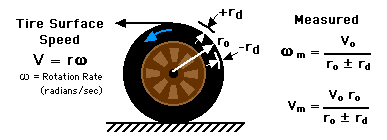
|
-- Acceleration due to Gravity -- Vehicle Acceleration and Braking -- General Equations |
Objects in a free fall increase in speed with time and distance. The exact rate depends on gravity, which varies slightly with location on the earth. The earth is not a perfect sphere and gravity varies slightly depending on location. By International definition 9.80665 meters per second per second is the gravitational acceleration constant, 1g = 9.80665 m/s2 exactly.
| 9.80665 | m / s2 |
| 32.17405 | ft / s2 |
| 21.93685 | mph / s |
| 35.30394 | kph /s |
| 19.06260 | knots / s |
|
mph kph knots |
- miles / hour - kilometers / hour - nautical miles / hour |
ft m s |
- feet - meters - seconds |
Acceleration g's
Acceleration and deceleration (negative acceleration) is change in speed over time and can be compared to the Gravitational Constant (g). Acceleration g's is not a force, it is a fixed baseline comparing acceleration to the gravity constant. Force is mass multiplied by acceleration (F = m a).
Acceleration comparisons are for dry flat surfaces using properly inflated tires in good to excellent condition.

Maximum acceleration and braking depends on;
Horsepower and drive wheels are additional factors for acceleration. Production muscle cars can go from 0 to 60 mph in 5 seconds (+0.55 g's). An electric vehicle can go 0 to 60 mph in 4 seconds.
| Time | 0 | 1 | 2 | 3 | 4 | 5 | sec |
| Speed | 0 | 12 | 24 | 36 | 48 | 60 | mph |
| Distance | 0 | 9 | 35 | 79 | 141 | 220 | feet |
| Time | 0 | 1 | 2 | 3 | 4 | sec |
| Speed | 0 | 15 | 30 | 45 | 60 | mph |
| Distance | 0 | 11 | 44 | 99 | 176 | feet |
|
Calculate Acceleration from Time and Speed a = v / t |
||
|---|---|---|
| Speed: 0 to | ||
| Time: | Seconds | |
|
Acceleration | ||
|
Calculate Acceleration from Distance and Speed a = v2 / 2 d |
||
|---|---|---|
| Speed: 0 to | ||
| Distance: | ||
|
Acceleration | ||
Vehicle Braking
Braking rate can be expressed in acceleration g's, feet per second every second (ft/s2), miles per hour per second (mph/s), meters per second second (m/s2), or kilometers per hour per second (kph/s). Vehicle Radar Adaptive Cruise Control automatically brakes when approaching other vehicles. Braking rate varies from 0.3 to 0.5 g's.
| Driver Braking | ||
|---|---|---|
| g's | mph / sec |
Description |
| 0.30 | 6.6 | Safe |
| 0.35 | 7.7 | Safe |
| 0.47 | 10.3 | Average Driver Max |
| 0.50 | 11.0 | Automatic Braking Max |
| 0.62 | 13.6 | Reasonably Skilled Driver Max |
| 0.66 | 14.3 | Skilled Driver Max |
| 0.70 | 15.4 | Vehicle Max |
| 1.00 | 21.9 | Gravity Constant |
| Vehicle Maximum Braking | |||
|---|---|---|---|
| Model | g's | ft/s2 | mph/s |
| Dodge Colt GL | 0.72 | 23.2 | 15.8 |
| Chevy Blazer | 0.76 | 24.5 | 16.7 |
| Nissan Maxima | 0.85 | 27.3 | 18.6 |
| Lincoln Continental | 0.92 | 29.6 | 20.2 |
| Toyota Celica GT | 0.94 | 30.2 | 20.6 |
| BMW M3 | 1.0 | 32.3 | 22.0 |
|
60 mph to Stop Production years 1991 - 1995 |
|||
| Convert Acceleration Units | |
|---|---|
|
g's |
|
Many safety experts use 15 ft/sec2 (0.47 g's) as the maximum deceleration that is safe for the average driver to maintain control, good to excellent tires, dry surface. A reasonably skilled driver can stop at 20 ft/sec2 (0.62 g's). Most production street vehicles have a maximum braking around 0.8 g's.
|
t = time v = speed at time t vo = speed when t = 0 d = distance traveled at time t a = acceleration (-a for deceleration) |